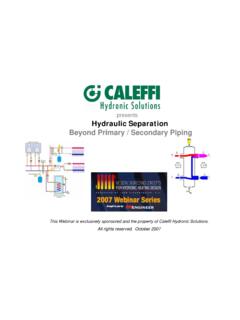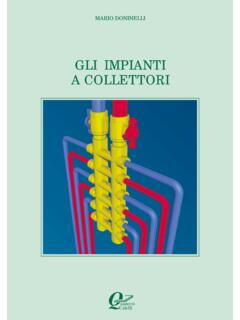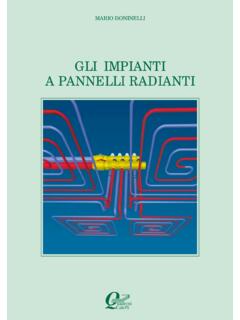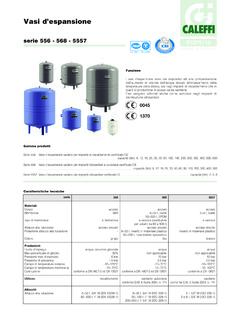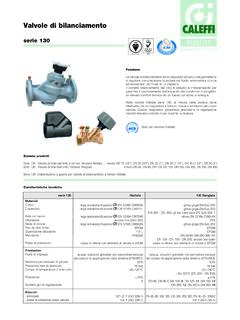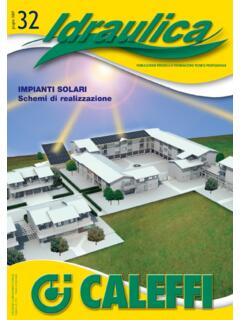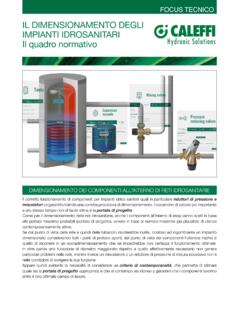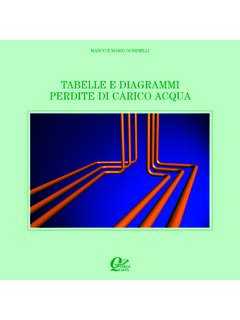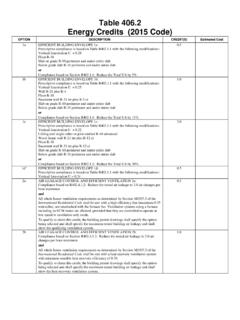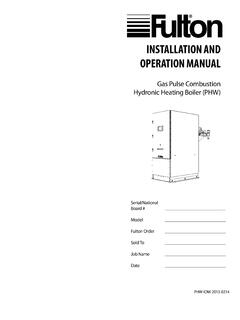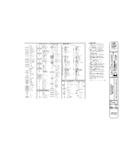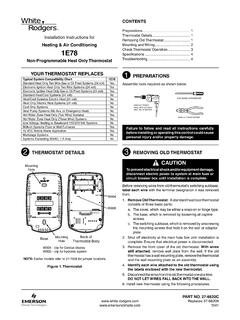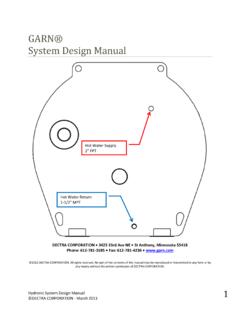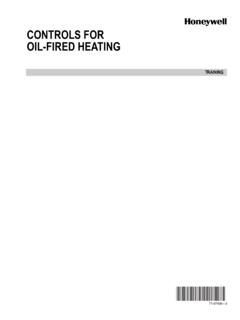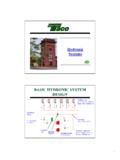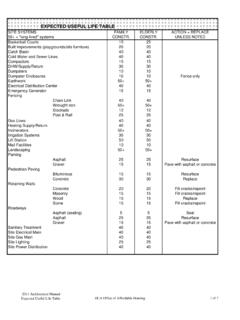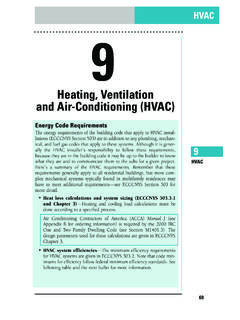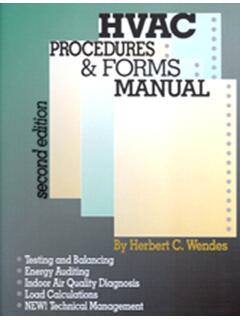Transcription of DESIGN PRINCIPLES OF HYDRONIC HEATING SYSTEMS
1 AndbooksCaleffiMARIO DONINELLIDESIGN PRINCIPLESOF HYDRONICHEATING SYSTEMS andbooksCaleffiRealization and printingGrafiche Nicolini & EDITORE CALEFFI MARIO DONINELLIDESIGN PRINCIPLESOF HYDRONICHEATING SYSTEMS andbooksCaleffiFOREWORDThe publication of this second Caleffi manual gives me the opportunity of thankingall those who, after the publication of the first Manual, have supported our initiativewith their comments, advice and messages of must confess that the project has given me a great deal of pleasure even though itsi not an easy one. Our aim is not to publish all types of books but to bring outnew publications designed to meet the specific requirements of those who designand manufacture HEATING and cooling SYSTEMS . It is for this reason that we haveplaced the compilation in the hands of professionals who have wide experience intheir particular fields. We feel that it is their direct contact with everyday situationswhich is essential for highlighting the real problems of HEATING engineers and forprovinding sensible solutions and useful intend therefore to concentrate on the clarity of the text and the graphic qualityof our manuals.
2 BUSY engineers do not have time to work through books which arenot clear or have no practical use. We consider it our duty to do everything possibleto simplify their DESIGN work, and facilitate their obtaining information, by providingclear diagrams, drawings which are easy to follow and tables which are easy toconsult. In other words we want to cover the technical details with the same, attimes almost fanatical, care with which we DESIGN and manufacture our products. Itis this commitment to the care we take over our products and our constant desireto improve quality which is the main characteristic of our method of working withthose who have, and those who will, place their trust in our I should like to express my thanks to Engineer Mario Doninelli who is also theauthor of this second Manual. A long friendship and the same spirit of dedicationmake it easy for us to co-operate I shall be very grateful to those who would like to let us have their opinionsor advice on this new publication.
3 Comments of this type, apart from providing animportant audit of our work, also provide a significant opportunity for our getting toknow those from outside company that we at Caleffi consider CaleffiChairman of CALEFFI this second manual I have rearranged and updated the text of my working filesrelating to HEATING circuits and heat the section covering the circuits I felt it was desirable to highlight the numericalexamples so that notes and observations of general interest could be drawn fromthem. I have chosen to avoid hypothetical situations and to base my book on actualsystems which are suitable for demonstrating the essential technical aspectsrelating to the choice and DESIGN of the circuits. I have given a number of examples of a theoretical nature in order to show how theparameters involved interact. To know how to assess the true significance of thesefactors makes it possible to develop an analytical attitude towards the simplifiedhypotheses and approximations which are addition examples have been included to demonstrate the use of the proposedpractical procedures within the scope of the individual items.
4 With procedures ofthis type it has been possible to significantly reduce the effort required fortheoretical calculations. In the second section of the manual I have examined the heat emitters, analysingthem from the following points of view:1. structural and performance characteristics2. heat output provided under various operating conditions3. commissioning and maintenance has been achieved by analysing the main factors governing the choice of typeand size, position and maintenance of the should like to thank Paolo Barcellini of Caleffi and my friends in the STC office,Umberto Bianchini and Roger Brescianini for the invaluable assistance they havegiven should also like to thank the Caleffi company who provided me with everything Ineeded to complete this manual and have it printed. Mario DoninelliPREFACEINTRODUCTIONGENERAL LAYOUTD efinitions, graphs, tables, formulae, examples and advice have been collected conti-nuously in the form of headings (or cards).
5 In the first section of the book the hea-dings have been arranged in a logical sequence as shown in the summary on page the second section however the headings are arranged in albhabetical heading is, practically speaking, self-sufficient. The connection between oneheading and another is indicated by suitable cross references. Each cross reference isclearly indicated and included between , tables and formulae have been numbered but these are only relevant withinthe section in wich they occur. Important subject headings, often introduced by abrief family tree, are subdivided into chapters and sub AND DRAWINGSThe sections are complemented by diagrams and drawings which illustrate the func-tional aspect of the SYSTEMS , equipment and components described. Working techni-cal drawings are not , SYMBOLS AND ABBREVIATIONSS igns and symbols (mathematical, physical and chemical symbols etc.)
6 Are those incurrent use. I have tried to avoid the use of abbreviations as much as possible andthose which have been used are identified on a case by case OF MEASUREMENTThe International System has not been strictly applied in the text and frequentlyother units of measurement have been used for preference where:1. they are more comprehensible from a practical point of view;2. they are the effective units of measurement which form part of the workinglanguage of engineers and ALPHABETP hysical quantities, numerical coefficients and constants are frequently representedby letters of the Greek alphabet. I felt it was desirable therefore to give below theseletters and their relative of the Greek alphabetCapitalSmall CaseName CapitalSmall CaseName alfa ni o nu beta xi gamma omicron delta pi epsilon rho zeta sigma eta tau theta upsilon iota fi cappa chi lambda psi mi o mu omega_____NOTESBALANCING BYPASS PRESSURE CONTROLLERS FOR CIRCULATING FOR SIMPLE CIRCUITS.
7 11 PRACTICAL CALCULATION OF SIMPLE CIRCUITS ..18 TABLE 1 - Conversion factors fro flow rate against variation in head ..19 CHARACTERISTICS OF SIMPLE OF SIMPLE OF REVERSE RETURN CIRCUITS ..31 CHARACTERISTICS OF REVERSE RETURN CIRCUITS ..35 APPLICATIONS OF REVERSE RETURN 3 First SectionHYDRONIC HEATING AND AIR CONDITIONG SYSTEM CIRCUITSBALANCED CIRCUITSpag. 5 SIMPLE CIRCUITSpag. 10 REVERSE RETURN CIRCUITSpag. 30 TABLE OF CONTENTSCALCULATION OF THE CIRCUITS WITH BALANCING VALVES ..39 CHARACTERISTICS OF THE CIRCUITS WITH BALANCING VALVES ..45 APPLICATIONS FOR WHICH CIRCUITS WITH BALANCING VALVES ARE USED ..46 CALCULATION OF THE CIRCUITS WITH OF THE CIRCUITS WITH AUTOFLOW ..53 APPLICATIONS FOR WHICH CIRCUITS WITH AUTOFLOW ARE USED ..54 DETERMINING THE DIMENSIONS OF CIRCUITS WITH THREEWAY CONTROL VALVES ..57 DETERMINING THE DIMENSIONS OF CIRCUITS WITH TWOWAY CONTROL VALVES.
8 67 CIRCUITS WITH BALANCING VALVESpag. 38 CIRCUITS WITH AUTOFLOWpag. 48 CIRCUITS WITH THREEWAY CONTROL VALVESpag. 56 CIRCUITS WITH TWOWAY CONTROL VALVESpag. - HORIZONTAL UNIT HEATERS ..76- VERTICAL UNIT HEATERS ..77 CHOISE OF UNIT - INSTALLATION OF UNIT HEATERS ..78- AIR OUTLET TEMPERATURE FROMUNIT HEATERS ..82- PERMISSIBLE NOISE LEVEL ..84 UNIT HEATER TABLE. 1 - Acceptable leveles of environmental noise ..85 NOMINAL HEAT OUTPUT OF A UNIT DESIGN TEMPERATURE OF THE HEATING EFFECTIVE HEAT OUTPUT OF A UNIT - CORRECTION FACTOR FOR FLUID TEMPERATURE VARIATION ..88 TABLE. 2 - Corrective factor for fluid temperature variation ..90- CORRECTION FACTOR FOR THE EFFECT OF ALTITUDE ..91 TABLE. 3 - Correction factor for the effect of altitude ..91- CORRECTION FACTOR FOR THE VELOCITY OF THE FLUID .. CAST IRON RADIATORS ..94- STEEL RADIATORS ..95- ALUMINIUM RADIATORS ..98 INSTALLING NOMINAL HEAT OUTPUT OF A 100 DESIGN TEMPERATURE OF THE HEATING 100 EFFECTIVE HEAT OUTPUT OF A 101 - CORRECTION FACTOR FOR FLUID TEMPERATURE VARIATION.
9 102 TABLE. 1 - Correction factor for fluid temperature variation (tm= 80 C, ta= 20 C) .. 104 TABLE. 2 - Correction factor for fluid temperature variation (tm= 70 C, ta= 20 C) .. 105- CORRECTION FACTOR FOR ALTITUDE .. 106 TABLE. 3 - Correction factor for altitudee .. 106- CORRECTON FACTOR FOR ENCLOSING THE RADIATOR .. 107- CORRECTION FACTOR FOR THE RADIATOR CONNECTION ORIENTATION .. 108- CORRECTION FACTOR FOR THE EFFECT OF THE PAINTING .. 109 RADIATORSpag. 93 UNIT HEATERSpag. 75 Second SectionHEATING AND AIR CONDITIONINGSYSTEM TERMINAL UNITSCLASSIFICATION .. 112 - CONVECTORS WITH SINGLE FINS .. 112- CONVECTORS WITH FINNED CHANNELS .. 115- CABINET CONVECTORS .. 116- BASEBOARD CONVECTORS .. 117 NOMINAL HEAT OUTPUT OF A CONVECTOR .. 118 DESIGN TEMPERATURE OF THE HEATING FLUID .. 118 EFFECTIVE HEAT OUTPUT OF A CONVECTOR .. 119 - CORRECTION FACTOR FOR FLUID TEMPERATURE VARIATION.
10 120 TABLE. 1 - Correction factor for fluid temperature variation (tm= 80 C, ta= 20 C) .. 122 TABLE. 2 - Correction factor for fluid temperature variation (tm= 70 C, ta= 20 C).. 123- CORRECTION FACTOR FOR ALTITUDE .. 124 TABLE. 3 - Correction factor for altitude .. 124- CORRECTION FACTOR FOR THE TYPE OF INSTALLATION .. 125- CORRECTION FACTOR FOR THE VELOCITY OF THE FLUID .. 125 INSTALLATION OF RADIANT AND NATURAL CONVECTION EMITTERS .. 128 TABLE. 1 - Minimum installation height of the emitters .. 128 NOMINAL HEAT OUTPUT OF RADIANT AND NATURAL CONVECTION 130 DESIGN TEMPERATURE OF THE HEATING FLUID .. 130 EFFECTIVE OUTPUT OF RADIANT AND NATURAL CONVECTION EMITTERS .. 131 - CORRECTION FACTOR FOR FLUIDTEMPERATURE VARIATION .. 132 TABLE. 2 - Correction factor for fluid temperature variation .. 134- CORRECTION FACTOR FOR INSTALLATION HEIGHT .. 135 TABLE.
